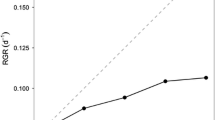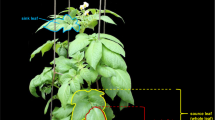Abstract
Carbon-14 pulse labeling technique was used to study the effect of rooting medium salinity and form and availability of N on growth and rhizodeposition of wheat (Triticum aestivum L.). Thirty days old plants grown in continuously aerated Arnon and Hoagland nutrient solution were subjected to 14C pulse labeling for 24 h and transferred to aqueous rooting medium containing 0, 150, and 300 mM NaCl in all combinations with different forms (calcium nitrate, ammonium sulphate, and ammonium nitrate) and amounts (0.5, 1.0, 1.5, and 2.0 times the standard N concentration (150 ppm) of Arnon and Hoagland plant growth medium). Plant samples immediately after pulse labeling, following 7 days of growth under different rooting medium conditions, and the freeze-dried rooting medium were analyzed for total C and 14C. Length and fresh/dry weight of root and shoot portions and calculated values of unaccounted 14C were determined. Presence of NaCl in the rooting medium led to a decrease in root and shoot portions. However, NO3 −-fed plants showed better growth than NH4 +-fed plants at all the three salinity levels. Salinity in rooting medium led to higher rhizodeposition and lower loss of 14C. Relatively higher proportion of 14C was released as rhizodeposits and retained in root/shoot portions of plants fed with NH4 + or NH4 ++NO3 −, than those with NO3 −, while less was respired. The specific activity of the rhizodeposits (kBq 14C g−1 C) was also higher under saline conditions. The rhizodeposits in NH4 +-fed plants were more highly labeled as compared to NO3 −-plants.



Similar content being viewed by others
References
Arnon DI, Hoagland DR (1940) Crop production in artificial culture solutions and in soil with special reference to factors influencing yields and absorption of inorganic nutrients. Soil Sci 50:463–484
Azam F, Sajjad MH (2005) Colorimetric determination of organic carbon in soil by dichromate digestion in a microwave oven. Pak J Biol Sci 8:596–598
Azam F, Simmons FW, Mulvaney RL (1993) Immobilization of ammonium and nitrate and their interaction with native N in three Illinois Mollisols. Biol Fertil Soils 15:50–54
Breland TA, Bakken LR (1991) Microbial growth and nitrogen immobilization in the root zone of barley (Hordeum vulgare L.), ryegrass (Lolium multiflorum Lam.), and white clover (Trifolium repens L.). Biol Fertil Soils 12:154–160
Christiansen-Weniger C, Van Veen JA (1991) NH4 +-excreting Azospirillum brasilense mutants enhance the nitrogen supply of a wheat host. Appl Environ Microbiol 57:3006–3012
Cramer MD, Lewis OAM (1993) The influence of NO3 − and NH4 + nutrition on the carbon and nitrogen partitioning characteristics of wheat (Triticum aestivum L.) and maize (Zea mays L.) plants. Plant Soil 154:289–300
Dakora FD, Philips DA (2002) Root exudates as mediators of mineral acquisition in low-nutrient environments. Plant Soil 245:35–47
Domanski G, Kuzyakov Y, Siniakina SV, Stahr K (2001) Carbon flow in the rhizosphere of Lolium perenne. J Plant Nutr Soil Sci 164:381–387
Gandhi AP, Paliwal KV (1976) Mineralization and gaseous losses of nitrogen from urea and ammonium sulphate in salt-affected soils. Plant Soil 45:247–255
Giordano M, Davis JS, Bowes G (1994) Organic carbon release by Dunaliella salina (Chlorophyta) under different growth conditions of CO2, nitrogen and salinity. J Phycol 30:249–257
Høgh-Jensen H, Schjoerring J (2001) Rhizodeposition of nitrogen by red clover, white clover and ryegrass leys. Soil Biol Biochem 33:439–448
Jansson SL (1958) Tracer studies on nitrogen transformations with special attention to mineralization-immobilization relationships. Ann R Agric Coll (Sweden) 24:101–361
Jones DL, Darrah PR (1995) Influx and efflux of organic acids across the soil-root interface of Zea mays L. its implications in rhizosphere C flow. Plant Soil 173:103–109
Khan MG, Silberbush M, Lips SH (1994) Physiological studies on salinity and nitrogen interaction in alfalfa. I. Biomass production and root development. J Plant Nutr 17:657–668
Kraffczyk I, Trolldenier G, Beringer H (1984) Soluble root exudates of maize (Zea mays L.): influence of potassium supply and rhizosphere microorganisms. Soil Biol Biochem 16:315–322
Kuzyakov Y, Domanski G (2000) Carbon input into the soil—review. J Plant Nutr Soil Sci 163:421–431
Kuzyakov Y, Domanski G (2002) Model for rhizodeposition and CO2 efflux from planted soil and its validation by 14C pulse labeling of ryegrass. Plant Soil 239:87–102
Kuzyakov JK, Kretzschmar A, Stahr K (1999) Contribution of Lolium perenne rhizodeposition for carbon turnover of pasture soil. Plant Soil 213:127–136
Kuzyakov Y, Ehrensberger H, Stahr K (2001) Carbon partitioning and below-ground translocation by Lolium perenne. Soil Biol Biochem 33:61–74
Kuzyakov Y, Biryukova OV, Kuznetzova TV, Molter K, Kandeler E, Stahr K (2002) Carbon partitioning in plant and soil, carbon dioxide fluxes and enzyme activities as affected by cutting ryegrass. Biol Fertil Soils 35:348–358
Lang B, Kaiser WM (1994) Solute content and energy status of roots of barley plants cultivated at different pH on nitrate or ammonium nitrogen. New Phytol 128:451–459
Lewis OAM, Leidi EO, Lips SH (1989) Effect of nitrogen source on growth response to salinity stress in maize and wheat. New Phytol 111:155–160
Liljiroth E, Baath E, Mathiasson I, Lundborg T (1990a) Root exudation and rhizoplane bacterial abundance of barley (Hordeum vulgare L.) in relation to nitrogen fertilization and root growth. Plant Soil 127:81–89
Liljiroth E, Van Veen JA, Miller HJ (1990b) Assimilate translocation to the rhizosphere of two wheat lines and subsequent utilization by rhizosphere microorganisms at two soil nitrogen concentrations. Soil Biol Biochem 22:1015–1021
Lodhi A, Azam F (1998) Yield and nitrogen uptake of wheat (Triticum aestivum L.) as affected by nitrapyrin and a nitrification inhibiting insecticide. Cereal Res Commun 26:305–312
Marschner H (1999) Mineral nutrition of higher plants, 2nd edn. Academic Press, London
Martins-Loução MA, Cruz C, Correia PM (2000) New approaches to enhanced ammonium assimilation in plants. In: Martins-Loucao MA, Lips SH (eds) Nitrogen in a sustainable ecosystem-From the cell to the plant, pp 349–360
Meharg AA, Killham K (1991) A new method of quantifying root exudation in the presence of soil microflora. Plant Soil 133:111–116
SAS Institute (1998) SAS/STAT users guide 2, version 7. SAS, Cary
Shaw LJ, Burns RG (2005) Rhizodeposits of Trifolium pretense and Lolium perenne: their comparative effects on 2, 4-D mineralization in two contrasting soils. Soil Biol Biochem 37:995–1002
Speer M, Kaiser WM (1994) Replacement of nitrate by ammonium as the nitrogen source increases the salt sensitivity of pea plants. II. Inter- and intracellular solute compartmentation in leaflets. Plant Cell Environ 17:1223–1231
Speer M, Brune A, Kaiser WM (1994) Replacement of nitrate by ammonium as the nitrogen source increases the salt sensitivity of pea plants. I. Ion concentrations in roots and leaves. Plant Cell Environ 17:1215–1221
Swinnen J, Van Veen JA, Merckx R (1994) 14C pulse labeling of field-grown spring wheat: an evaluation of its use in rhizosphere carbon budget estimations. Soil Biol Biochem 26:161–170
Trolldenier G, Von Rheinbaban W (1981) Root exudation and bacterial population of roots. I. Effect of nitrogen source, potassium nutrition and aeration of roots. Z Pflanzenernaehr Bodenkd 144:366–371
Vieira-Santos CL, Campos A, Azevedo H, Caldeira G (2001) In situ and in vitro senescence induced by KCl stress: nutritional imbalance, lipid peroxidation and antioxidant metabolism. J Exp Bot 52:351–360
Westerman RL, Tucker TC (1974) Effects of salts and salts plus nitrogen-15 labeled ammonium chloride on mineralization of soil nitrogen, nitrification and immobilization. Soil Sci Soc Am Proc 38:602–605
Author information
Authors and Affiliations
Corresponding author
Additional information
Communicated by W. Filek.
Acta Physiologiae Plantarum is deeply committed to publishing integrity and follows the guidelines of the Committee on Publication Ethics. Due to disputed authorship, this article must be considered withdrawn.
The retraction note to this article can be found online at http://dx.doi.org/10.1007/s11738-010-0663-y.
About this article
Cite this article
Akram, M., Ashraf, M.Y., Ahmad, R. et al. RETRACTED ARTICLE: Effect of root-zone salinity and form of N on photosynthate partitioning in wheat (Triticum aestivum L.). Acta Physiol Plant 30, 855–861 (2008). https://doi.org/10.1007/s11738-008-0191-1
Received:
Revised:
Accepted:
Published:
Issue Date:
DOI: https://doi.org/10.1007/s11738-008-0191-1




